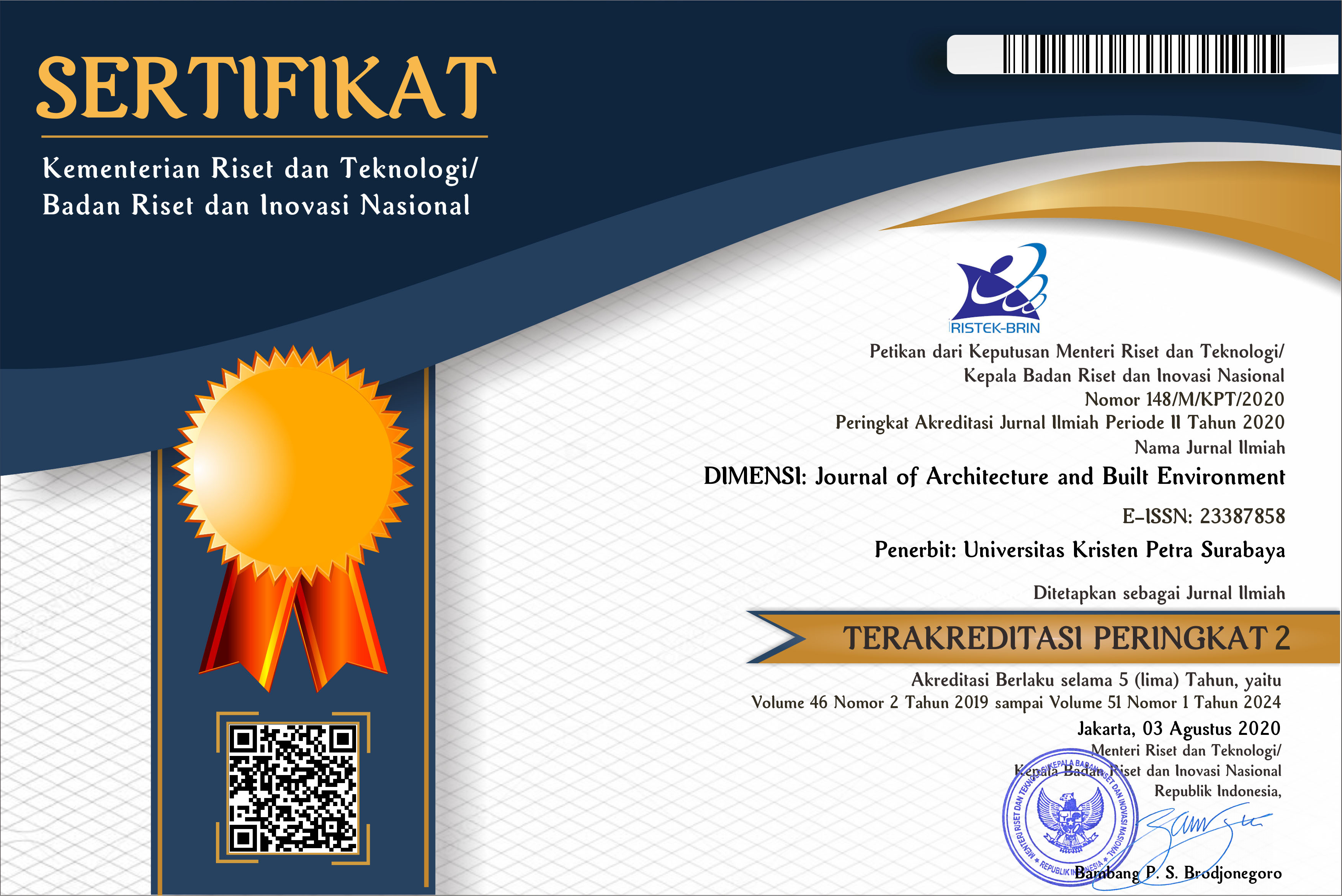Youth Appreciation of The Existence of Historical Buildings (Vredeburg Fort)
 :
:
https://doi.org/10.9744/dimensi.51.1.1-7
Keywords:
perception, appreciation, young people, Fort VredeburgAbstract
Yogyakarta is a city that has a diverse history and cultural heritage both physically and non-physically. Physically in the form of buildings - historical heritage buildings such as the Vredeburg Fort building which is one of the relics of VOC colonialism in the city of Yogyakarta since 1765. Now its existence has changed its function to become a historical heritage fort and its presence as a historical heritage building now greatly affects the sense of concern in the current era, especially the younger generation of the current era. As a result, the awareness of knowing and appreciating historical buildings is low due to the advancement of civilisation. The purpose of this research is to explore the perceptions of young people that lead to appreciation of Fort Vredeburg in the current era. The research method applied by conducting observations, data collection and questionnaire interviews. The result of this research is to reveal the form of appreciation from young people's perception towards Fort Vredeburg today.
Downloads
References
Aplin, G. (2002). Heritage: Identification, Conservation, and Management. Oxford University Press: Oxford, UK.
Appeleyard, D. (1976). Planning a Pluralistic City. The MIT Press.
Azwar (1988:21). Perception Component.
Bogner, W. (1997). Environmental Perception of Rural and Urban. Ludwig- Maximilians-University, Barbarastrasse, Munchen, Germany.
Boito, C. (2009). Restoration in Architecture: First Dialogue. Future Anterior.
Bloom, S. B. (1956). Affective.
Chand, T. (2006). Educational Technology. India: J. L. Kumar for Anmol Publications Pvt. Ltd.
Chaplin (2002). Cognitive.
Departemen Pendidikan dan Kebudayaan. (1986). Museum Benteng Vredeburg Yogyakarta.
Faizah, R. S. N. (2020). Ethnomatematics: Vredeburg Fort Analysis in Terms of Geometry. Universitas Tidar, Jawa Tengah.
Gatersleben, B, et al. (2002). The measurement and determinants of environmentally significant consumer behaviour. Environment and Behaviour, 34, 335–362.
Hatmosuprobo, S. (1979). Yogyakarta City and Fort Vredeburg Yogyakarta. Institute for Rural Studies and Gadjah Mada University area.
ICOM (International Council of Museums). (2007). Museum.
ICOMOS. (2013). The Burra Charter: The AustraliaI COMOS Charter for Places of Cultural Significance.
Inajati,A. (2014). Benteng Dulu, Kini dan Esok. Yogyakarta: Kepel Press.
Ittelson, W. H. (1978). Environmental perception and urban experience. Environment and Behavior, 10(2), 193–213.
Kalali, P. (2015). Meaningful Perception of Place. Islamic Azad University, Central Tehran Branch, Masyhad Iran.
Kapoor, C., & Solomon, N. (2011). Understanding and managing generational differences in the workplace. Emerald Insight, 3(4), 308-318.
Kastanakis. (2013). The Effect of Culture on Perception and Cognition.
Kementerian Kesehatan Republik Indonesia. (2009). Kategori Usia.
Krathwohl, R. D. (1973). Affective.
Kotler, P. (2004). Perception.
Kumar, D. (2021). Residents' Perception toward Geoheritage Conservation.
Merleau-Ponty, M. (1998). Phenomenology of Perception. Translated by C. Smith London and New York: Routledge.
Naafs, S., &White, B. (2012). Intermediate generation: Reflections on Indonesian youth studies. Jurnal Studi Pemuda, 1(2), 91.
Netzer, L., Gutentag, T., Kim, M. Y., Solak, N., & Tamir, M. (2018). Evaluations of emotions: Distinguishing between affective, behavioral and cognitive components. Personality and Individual Differences, 135, 13-24. https://doi.org/10.1016/j.paid.2018.06.038.
Patmonodewo. (2003). Kognitif.
Potter, W. J., & Levine-Donnerstein, D. (1999). Rethinking validity and reliability in content analysis. Journal of Applied Communication Research, 27, 258-28.
Prasetijo, R. (2005). Faktor Internal dan Faktor Eksternal Persepsi.
Raptis, G. E., Fidas, C., Katsini, C., Avouris, N. (2019). A cognition-centered personalization framework for cultural-heritage content. User Modeling and User-Adapted Interaction, 29, 9–65 https://doi.org/10.1007/s11257-019-09226-7.
Rieswansyah, A. (2022). One of the preservation activities at the Fort Vredeburg Museum in Yogyakarta efforts to preserve past knowledge. Journal of Mathematics Education, 2(1), 64-70. Print ISSN: 2716-4497; Online ISSN: 2721-1738.
Robbins, S. P. (2003). Perception.
Rukmana, I. (2019). Strategy for the Management of the Fort Vredeburg Museum as a Cultural Heritage Tourism in Yogyakarta. Universitas Universal Batam, Kepulauan Riau.
Schwartz, et al. (2019). Sensation and perception. Florida International University, John H. Krantz, Hanover College. SAGE: Los Angeles.
Susanto. (2012). Kognitif.
Undang-Undang No. 40 Tahun 2009 pasal 1.1.
Varutti. (2022). The affective turn in museums and the rise of affective curatorship, museum management and curatorship. DOI: 10.1080/09647775.2022.2132993.
Walgito, B. (1997). Pengantar Psikologi Umum. Andi Offset: Yogyakarta.
Wang, P., & Soergel, D. (1998). A cognitive model of document use during a research project. Study I. Document selection. Journal of the American Society for Information Science, 49(2), 115–133.
World Health Organization. (2021). Age Category.
Wijaya, D. N. (2013). Youth mentality during the movement and reform period in Indonesia: Dari dare to be knowledgeable to fear of knowledge. Journal of Historical Studies & History Education, 1(1), 77-78.
Yin, R. K. (2006). (Terj), Studi Kasus, Desain dan Metode. Rajawali Press: Jakarta.
Zuhriyah, I. A. (2007). Afektif.
Downloads
Published
How to Cite
Issue
Section
License
Authors who publish with this journal agree to the following terms:
- Authors retain copyright and grant the journal right of first publication with the work simultaneously licensed under a Creative Commons Attribution License that allows others to share the work with an acknowledgement of the work's authorship and initial publication in this journal.
- Authors are able to enter into separate, additional contractual arrangements for the non-exclusive distribution of the journal's published version of the work (e.g., post it to an institutional repository or publish it in a book), with an acknowledgement of its initial publication in this journal.
- Authors are permitted and encouraged to post their work online (e.g., in institutional repositories or on their website) prior to and during the submission process, as it can lead to productive exchanges, as well as earlier and greater citation of published work (See The Effect of Open Access).



















